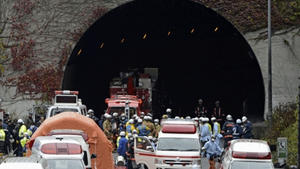InfrastructureTunnel disaster shows age of Japan’s infrastructure, but there is no money to fix it
The collapse of hundreds of concrete ceiling slabs in a tunnel just outside Tokyo has focused the attention of the Japanese on the country’s has citizens calling for Japan to fix its aging infrastructure; the amounts of money needed for this refurbishing are large, and , but signs indicate that Japan may not have the money, as the public debt is already more than 200 percent of its Gross Domestic Product (GDP)

Japanese tunell collapse, killing nine, shows age of infrastructure // Source: tuiban.net
The collapse of hundreds of concrete ceiling slabs in a tunnel just outside Tokyo has focused the attention of the Japanese on the country’s aging infrastructure. The amounts of money needed for this refurbishing are large, and Japan may not have the money.
ABC News reports that Nine people were killed in the tunnel last week, which serves as a major link between the capital and central Japan. The tunnel opened in 1977 during the country’s postwar construction boom. About 270 concrete slabs collapsed onto the road deep inside the Sasago Tunnel, falling on three moving vehicles. Investigators and civil engineers who looked into the cause for the collapse could not find any evidence of negligence or sabotage.
The slabs weighed 1.4 metric tons each, and fell over a stretch of more than 100 meters. The Slabs were suspended from the arched roof of the tunnel. The operator of the tunnels aid the bolts holding the slabs in place may have weakened with age. The panels were installed when the tunnel was built.
Immediately following the accident, the transport ministry ordered inspections of forty-nine other highway and road tunnels with similar architectural designs.
Slow economic growth and budgetary pressure have led to delays in even the most basic maintenance of infrastructure, and now the transportation system may require significant improvements.
ABC News notes that the infrastructure ministry, which is in charge land and roads, joined with three government highway operators in November to form a panel on how fix aging expressways and tunnels.
Experts quoted bythe Yomiuri newspaper say that more than 30 percent of the 8,716 kilometers of Japanese expressways have been in operation for more than thirty years, with but minimal maintenance work.
Toyoaki Miyagawa, a Kyoto University expert, told Yomiuri that countermeasures were “urgently needed” because the tunnels were built to handle much lighter traffic loads than today’s. Funding such projects could be a problem for Japan, as the public debt is already more than 200 percent of its Gross Domestic Product (GDP).
‘‘Basically, we didn’t spend enough on renovating our decaying water pipes, bridges and tunnels. We didn’t spend enough on public infrastructure,’’ Masashiro Matsumura, a politics professor at St. Andrews University in Oskaa, Japan, told Boston.com.
Andrew DeWitt, a professor at Tokyo’s Rikkyo University, wondered whether, after the Fukushima disaster, Japan has the funds to fix all these issues at the same time. ‘‘Now you have this tunnel that fell apart. That has reignited enthusiasm for construction,’’ DeWitt told Boston.com. ‘‘The question is, do they have the money to spend on that?’’
